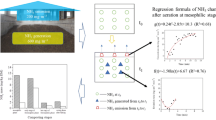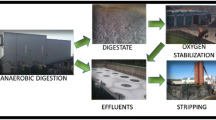Abstract
Composting municipal wastewater sludge may generate composting wastewater (acid washer water and tunnel wastewater) with high ammonium–nitrogen (NH4–N) concentration; this kind of wastewater is usually generated in a rather small daily amount. A procedure of air stripping with catalytic oxidation was developed and tested with pilot-scale and full-scale units for synthetic disposal of the high NH4–N wastewaters from composting facilities. In air stripping, around 90% NH4–N removal efficiency was reliably achieved with a maximum of 98%. A model to describe the stripping process efficiency was constructed, which can be used for process optimization. After catalytic oxidation, the concentrations in the outlet gas were acceptable for NH3, NOX, NO2, and N2O, but the NH3 and N2O concentrations limited the feasible loading range. The treatment costs were estimated in detail. The results indicate that air stripping with the catalytic oxidation process can be applied for wastewater treatment in composting facilities.









Similar content being viewed by others
References
Ahlström-Silversand, F. (1996). Catalytic combustion in environmental protection and energy production. Sweden: Lund University.
Baumgarten, G., & Seyfried, C. F. (1996). Experiences and new developments in biological pretreatment and physical post-treatment of landfill leachate. Water Science and Technology, 34(7–8), 445–453.
Carrera, J., Vicent, T., & Lafuente, J. (2004). Effect of influent COD/N ratio on biological nitrogen removal (BNR) from high-strength ammonium industrial wastewater. Process Biochemistry, 39, 2035–2041.
Collivignarelli, C., Bertanza, G., Baldi, M., & Avezzù, F. (1998). Ammonia stripping from MSW landfill leachate in bubble reactors: process modeling and optimization. Waste Management and Research, 16(5), 455–466.
Dräger Safety AG & Co. (2001). Dräger-Tubes-/CMS-Handbook, 12th Edn, KGaA Lübeck.
Eden, R. (2000). Removal of ammonia from landfill leachate in Hong Kong. Organics Ltd.
EPA (1993). Manual nitrogen control. U.S. Environmental Protection Agency EPA/625/R-93/101.
Energy review (2007). 1/2007 Ministry of Trade and Industry, Finland.
Everaert, K., & Baeyens, J. (2004). Catalytic combustion of volatile organic compounds. Journal of Hazardous Materials B, 109, 113–139.
Li, Y., & Armor, J. N. (1997). Selective NH3 oxidation N2 in a wet stream. Applied Catalysis B: Environmental, 13(2), 131–139.
Lu, G. (2002). Catalytic oxidation of ammonia to nitrogen. Technische Universiteit Eindhoven, ISBN 90-386-2653-3.
Gunay, A., Karadag, D., Tosun, I., & Ozturk, M. (2008). Use of Magnesit as a Magnesium Source for Ammonium Removal from Leachate. Journal of Hazardous Materials, 15, 619–623.
Huang, T. L., Keith, R., & Jordan, M. (2000). The removal of ammonia from water by a hydrophobic catalyst. Enivronmental Science & Technology, 34(22), 4804–4809.
ISO International Standard (2005). Water quality — determination of ammonium nitrogen — method by flow analysis (CFA and FIA) and spectrometric detection, ISO 11732.
Kumagai, S., & Koda, S. (1999). Passive sampling and head space analysis for quantitative determination of nitrous oxide exposure. American Industrial Hygiene Association Journal, 60, 458–462.
Markes International (2005). Note 18: Development in the determination of nitrous oxide using thermal desorption — GC. http://www.markes.com. Accessed February 2009.
Metcalf & Eddy. (2003). Wastewater Engineering Treatment and Reuse (4th ed.). New York: Mc Graw Hill.
Mulder, J. W., van Loosdrecht, M. C. M., Hellinga, C., & van Kempen, R. (2001). Full-scale application of the SHARON process for treatment of rejection water of digested sludge dewatering. Water Science and Technology, 43(11), 127–134.
Olofsson, G., Wallenberg, R., & Andersson, A. (2005). Selective catalytic oxidation of ammonia to nitrogen at low temperature on Pt/CuO/Al2O3. Journal of Catalysis, 230, 1–13.
Pelkonen, M., Kotro, M., & Rintala, J. (1999). Biological nitrogen removal from landfill leachate: a pilot scale study. Waste Management and Research, 17, 493–497.
Reynolds, T. D. (1982). Unit Operations and Processes in Environmental Engineering. Brooks/Cole Engineering Div. Monterey, USA.
SFS Finnish Standards Association (1997). Water Quality. Determination of Nitrite Nitrogen and Nitrate Nitrogen and the Sum of Both by Flow Analysis (CFA and FIA) and Spectrometric Detection, SFS-EN 13395.
Statistix for Windows by analytic software (2008). Statistix http://www.statistix.com/. Accessed March 2009.
Terada, A., Hibiya, K., Nagai, J., Tsuneda, S., & Hirata, A. (2003). Nitrogen removal characteristics and biofilm analysis of a membrane-aerated biofilm reactor applicable to high-strength nitrogenous wastewater treatment. Journal of Bioscience and Bioengineering, 95(2), 170–178.
Theilen, U. (1995). Behandlung von Sickerwasser aus Siedlungsabfalldeponien. Betriebsergebnisse und Kosten grosstechnischer Behandlungsanlagen. Heft 91. Hannover, Germany. Veröffentlichungen des Institutes fuer Siedlungswasserwirtschaft und Abfalltechnik der Universität Hannover. (in German).
Author information
Authors and Affiliations
Corresponding author
Appendix
Appendix
1.1 Cost estimation
The cost estimation is based on a credible assumption as the air-stripping system is running consistently at the same level of overall efficiency. The utilities of electricity, heating oil, and biogas as energy sources are compared from the point of economy. Biogas sources are distinguished as commercial purchase and cost-free supply from the close landfills or anaerobic digestion facilities. The latter is thought of as free in the cost estimation. To avoid complication and interference with individual cases, the air-stripping process is pre-digested, as illustrated in Fig. 10, and operational costs are defined mainly as chemicals cost and energy cost. It is assumed that 50% thinner and 50% heat are recycled between the sequential two batches. Two parallel stripping reactors are used.
Based on titration tests, the relationship of pH and chemical cost is defined as
where
- C CN :
-
cost of alkali addition with NH4–N loading (EUR/kg NH4–N loading)
- UP:
-
unit price of alkali (EUR/L)
- pH:
-
pH value expected
- τ :
-
process coefficients, usually 1.05
- N i :
-
the initial NH4–N concentration in composting wastewaters (mg/L)
Equation 2 is only applicable for the expected pH range of 9.3–9.7 and initial NH4–N concentration range of 2,500–10,000 mg/L. If the required pH were above this range, the cost would be almost double.
Based on Fig. 1, the energy cost is summarized as the energy needed for heating of acid washer water/stripping air and for aeration/alkali-feed pumps. Other daily energy consumptions such as lighting are not included in this estimation. Heater energy-use efficiency is assumed as 78%. Electricity, oil, and biogas are potential energy sources to estimate. Energy cost is expressed as
where
- C EN :
-
cost of energy with NH4–N loading (EUR/kg NH4–N loading)
- D :
-
density of composting wastewaters (kg/m3)
- c p :
-
specific heat capacity of composting wastewaters (J/kg°C)
- Q :
-
volume of air stripper batch (m3)
- T e :
-
temperature expected for composting wastewaters (°C)
- T i :
-
temperature initial for composting wastewaters (°C)
- D a :
-
density of air (kg/m3)
- c pa :
-
specific heat capacity of air (J/kg°C)
- DI:
-
dilution factor
- R :
-
ratio air to liquid volume, assumed as 2,400
- T ea :
-
temperature expected for air (°C)
- T ia :
-
temperature initial for air (°C)
- E A :
-
energy for aeration (kWh)
- E p :
-
energy for alkali feed pump (kWh)
- UP:
-
unit price of energy (EUR/kWh)
In these studied cases, composting wastewater (acid washer water) is usually generated only in small daily amounts. The requirement of capacity of the stripping system is not an acute factor. It is suggested that it is better to design the volume of air stripper batch (Q) in the range of 2 to 10 m3/day to achieve the optimal performance–price ratio.
The operational cost including chemicals cost and energy cost is calculated with Eq. 4.
where
- C N :
-
operational cost with NH4–N loading (EUR/kg NH4–N loading)
- F :
-
maintenance and loss coefficients, usually 1.05–1.1
Assumption: in a typical pilot-scale air-stripping process, a 9-kW air blower is used for aeration. Two 0.25-kW alkali-feed pumps are used for alkali feeding. The specification and cost estimation of the process are summarized in Table 6.
The capital and labor costs are estimated as well, based on EU Member States' conditions. The assumptions are that two 17.5-m3 plastic reactors, one catalytic VOC incinerator with a capacity of 1,000 m3/h, one air blower with a capacity of 1,000 m3/h, one heater and heat exchanger, and two alkali-feed pumps are the essential equipment in this system. Costs of the necessary monitoring systems including pH, temperature, and airflow probes and the accessories including valves and pipes are estimated too.
For a manual monitoring system, portable gas meters and weekly manual work of 8 h are used in the estimation. The estimated capital cost is EUR 120,000 and the labor cost is EUR 6,000/year. If an automatic monitoring system is used and online gas analyzers and probes are combined with the computer control system, the daily manual work will decrease considerably (to half an hour). The estimated capital cost is EUR 125,000, and the labor cost is EUR 2,000/year.
As a whole, in stripping, part of the capital costs were estimated as EUR 0.4/kg N and operation cost EUR 1.6–3/kg N removed, whereas in catalytic oxidation part, the capital costs were estimated as EUR 1/kg N and operation cost EUR 0.2/kg N removed.
Rights and permissions
About this article
Cite this article
Wang, Y., Pelkonen, M. & Kotro, M. Treatment of High Ammonium–Nitrogen Wastewater from Composting Facilities by Air Stripping and Catalytic Oxidation. Water Air Soil Pollut 208, 259–273 (2010). https://doi.org/10.1007/s11270-009-0164-z
Received:
Accepted:
Published:
Issue Date:
DOI: https://doi.org/10.1007/s11270-009-0164-z





